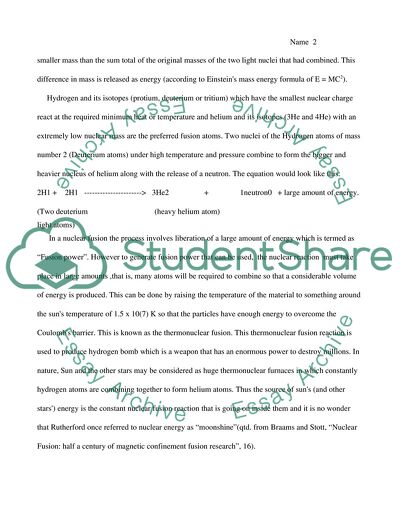
- Home
- Free Samples
- Premium Essays
- Editing Services
- Extra Tools
- Essay Writing Help
- About Us
- Studentshare
- Subjects
- Miscellaneous
- Discuss Nuclear Fusion: process, effects, apllications, and problems
Discuss Nuclear Fusion: process, effects, apllications, and problems - Essay Example

- Subject: Miscellaneous
- Type: Essay
- Level: Undergraduate
- Pages: 4 (1000 words)
- Downloads: 0
- Author: gkuhlman
Extract of sample "Discuss Nuclear Fusion: process, effects, apllications, and problems"
As Singh and Kaur define it “the process in which two nuclei of light elements (like that of hydrogen) combine to form a heavy nucleus (like that of helium) is called nuclear fusion ( Singh and Kaur,“Science for Tenth Class (part 1)”, 242). The nuclei of all atoms are positively charged (owing to the protons), so they try to repel each other when brought together and form an electrostatic force known as the Coulombs barrier. So an initial amount of heat energy and high pressure is required to force the nuclei to fuse together to form a bigger nucleus.
During this process of fusion there is a release of a tremendous amount of energy. There is a loss of mass during this process which appears as the released energy. When two light nuclei (hydrogen) combine together, they form a single nucleus (helium) with a slightly smaller mass than the sum total of the original masses of the two light nuclei that had combined. This difference in mass is released as energy (according to Einsteins mass energy formula of E = MC2). Hydrogen and its isotopes (protium, deuterium or tritium) which have the smallest nuclear charge react at the required minimum heat or temperature and helium and its isotopes (3He and 4He) with an extremely low nuclear mass are the preferred fusion atoms.
Two nuclei of the Hydrogen atoms of mass number 2 (Deuterium atoms) under high temperature and pressure combine to form the bigger and heavier nucleus of helium along with the release of a neutron. The equation would look like this: In a nuclear fusion the process involves liberation of a large amount of energy which is termed as “Fusion power”. However to generate fusion power that can be used, the nuclear reaction must take place in large amounts ,that is, many atoms will be required to combine so that a considerable volume of energy is produced.
This can be done by raising the temperature of the material to something around the suns temperature of 1.5 x 10(7) K so that the
...Download file to see next pages Read MoreCHECK THESE SAMPLES OF Discuss Nuclear Fusion: process, effects, apllications, and problems
Nuclear plants and seafood safety
Into a Clean and Safe Method of Manufacturing Power: Nuclear Energy
Nuclear Technology vs Nuclear Weapons
Genetic Engineering: Processes, Applications and Ethical Issues
Role of Middleware in the App Integration in a Distributed Application Environment
Integrity of high chromium steel dissimilar metal weld
Instrumental and Control Systems in Nuclear Power Plants
Process Improvement Application

- TERMS & CONDITIONS
- PRIVACY POLICY
- COOKIES POLICY